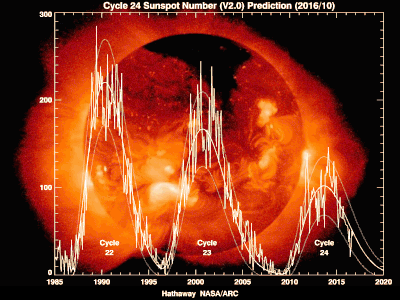The following plots come from the Wikipedia post on the Solar Cycle at https://en.wikipedia.org/wiki/Solar_cycle.


It has also long been recognized that the Suns solar radiance varies regularly with a period of about 11 years. This variance is noted in terms of the sun's sunspot activity.

It is amazing that the tree ring growth cycles preserved in the fossil record from the Permian reveal a 10.62 year solar cycle, almost identical to the present day 11 year cycle (Geology, 2017. L. Luthardt and R. Robler). The Permian period extends from about 250Mya-300 million years ago.
The figure below from https://spacemath.gsfc.nasa.gov/earth/Earth8.pdf reveals changes of solar irradiance or insolation (the solar power per unit area falling on Earth's surface usually measured at the top of the Earth's atmosphere. The spacemath article poses three problems that might be enjoyable to work through. Here I just note their observation that the variation in solar irradiance during a solar cycle is about 1.3 Watts per square meter about an average of around 1366 W/m-square. This corresponds to a variation of about 0.001 (one in a thousand) or about 0.1% of the average.
This is quite a small variation that would seem unlikely to influence global climate in any major way. We will take a brief look at this in the following discussion of the little ice age and the Maunder Minimum.
No comments:
Post a Comment